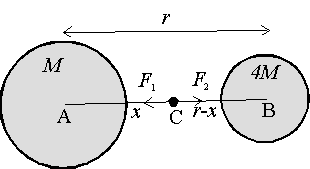Education Links
Leaving Cert
 Maths
Maths
 French
French
 English
English
 Chemistry
Chemistry
 Physics
Physics
 Biology
Biology
 Economics
Economics
 Spanish
Spanish
 Geography
Geography
 History
History
Junior Cert
1. Introduction
Newton’s Law of Gravitation describes the force of attraction between any two massive bodies (bodies which have mass).2. The Law
(a) Statement: The force of attraction between any 2 massive bodies is directly proportional to the product of their masses and inversely proportional to the square of the distance apart of their centre of mass.
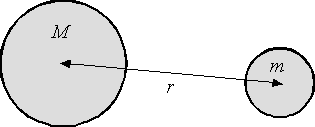
(b) Notes:
(i) Units: F: Newton (N); m, M: Kilogram (kg); r: Metre (m); G: (N m2 kg-2)
(ii) It is an example of an inverse-square law. This means that if F is the force of attraction between 2 massive bodies placed 1 metre apart then the force is F/4 at 2 metres, F/9 at 3 metres, etc..
(iii) Definition of G: The force of attraction between 2 bodies each of mass 1 kg placed 1 m apart in a vacuum is 6.7 ´ 10-11 N.
(iv) Remember r is the distance between the centres of masses of the bodies.
(v) The force is always an attractive one.
3. Derivation: The relationship between G and g
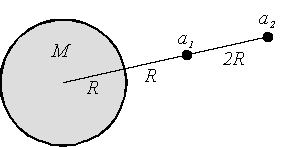 When a body falls under gravity the gravitational force causes it to accelerate. By Newton’s Law of Gravitation the force F on a body of mass m at a distance r from a body of mass M as shown is given by
When a body falls under gravity the gravitational force causes it to accelerate. By Newton’s Law of Gravitation the force F on a body of mass m at a distance r from a body of mass M as shown is given by  . According to Newton’s second law of motion this force produces in the body of mass m an acceleration given by F = ma.
. According to Newton’s second law of motion this force produces in the body of mass m an acceleration given by F = ma.
This is the acceleration due to gravity at a distance r from the centre of gravity of a body of mass M.
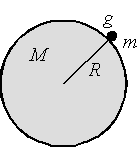 An important particular case is when the mass m is in contact with the mass M. Then a is called g. In this case
An important particular case is when the mass m is in contact with the mass M. Then a is called g. In this case
 where R is the radius of body of mass M.
where R is the radius of body of mass M.Notes:
(i) a is called the acceleration due to gravity at a distance r from the centre of gravity of body of mass M.
(ii) g is the acceleration due to gravity on the surface of the body of mass M.
(iii) The weight, W, of an object is the force of gravitational attraction towards the centre of the central massive body. Of course, it obeys the inverse square law.
Trick: If W is the weight on the surface of a body of radius R, then W/4 is the weight at a height R, W/9 at a height 2R, etc..
4. Experiments on Gravity
There is only one on the course, the measurement of the acceleration due to gravity g on the surface of the earth. This can be done by a simple pendulum or by free fall. The value of g varies somewhat over the surface of the earth because of the rotation of the earth and also because the earth is not a perfect sphere. The value of g is usually given as 9.8 ms-2.5. Types of Problem
Type 1: Simple (Fill in the numbers).Example 1
Find the force of attraction between the earth and the moon.Constants

Solution
Example 2
Find the acceleration due to gravity on the moon's surface.Constants

Solution
Type 3: Density Problems
The density D of any body is given by


For a sphere


Example 3
Find the mean density of the earth.Constants

Solution
Type 3: 2 points in the same gravitational field.
Trick: Write down the acceleration due to gravity at each point separately under one another using
 and divide. The mass M will cancel.
and divide. The mass M will cancel.Example 4
Compare the accleration due to gravity at a point a height R above a planet of mass M and radius R to that at a point a height 3R above it.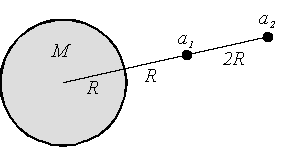
Example 5
Find the acceleration due to gravity at a height of 250 km above the surface of a body of radius 3.6´ 106 m if the acceleration due to gravity at the surface is 6.2 ms-2.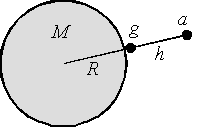
Example 6
To what height above the surface of the earth should a body be raised so that its weight is halved. (The acceleration due to gravity on the surface of the earth is 9.8 ms-2, radius of the earth is 6.4´ 106 m).Solution
Type 4: 2 points in different gravitational fields.
Trick: Write down the acceleration due to gravity for each body separately under one another using
 and divide. The mass M will not cancel.
and divide. The mass M will not cancel.Example 7
Compare the acceleration due to gravity at a height 2R above the surface of a body of mass 3M and radius R to that at a height R above a body of mass M and radius 3R.
Example 8
Compare the acceleration due to gravity on the surface of the earth to that on the surface of the moon. (Mass of the earth is 81.6 times the mass of the moon and the radius of the earth is 3.67 times the radius of the moon.)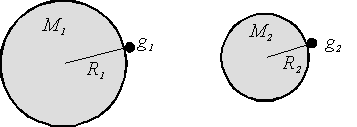
Type 5: An in-betweener
Example 9
Body A has a mass M and body B has a mass 4M. Their centres are a distance r apart as shown. If C is a point between A and B at which there is no net gravitational force, find the distance |AC| in terms of r.